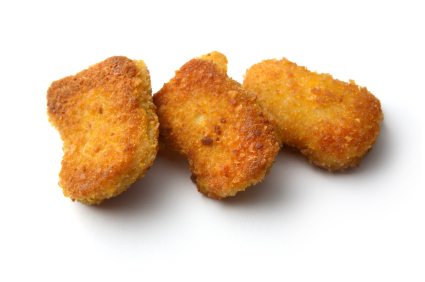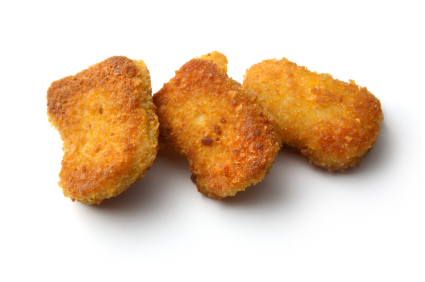When my info-larder gets too packed, it’s time to serve up some choice nuggets from around the Web.
—————-
 Get ’em while they’re hot.
Get ’em while they’re hot.
• Remember Fed Up with Lunch, my favorite stunt blog ever? In it, an anonymous teacher in the midwest does something that few adults would volunteer to do–not even ones who tolerate paltry lunch funding: She’s lunching daily on kid rations in her public-school cafeteria. Her blog is a graphic document of the brutalized food culture we’ve created in public schools. It’s all about cardboard “pizza” and tater tots and other overly rich, undernourishing fare.
Well I’m happy to report that the blogger–who calls herself Mrs. Q–is getting plenty of much-deserved attention. Good Morning America/ABC News interviewed her (I’ll be posting the video soon); Yahoo News profiled her. The New York Times mentioned her. She even had a phone chat with the crusading British chef/U.S. school lunch reformer Jamie Oliver. She reports:
About his experience with school lunches and also what I have been up to. Jamie is a passionate advocate for children’s school food and their health. I’m not going to detail what we talked about because it wasn’t an interview, but instead a deep discussion about school lunches and what the US is up against. It was a high point for me and the blog.
Given all the attention the likes of Mrs. Q and Jamie Oliver are training on the rotten quality of school lunch, I’m surprised and disappointed that there isn’t more outrage around the Senate’s miniscule proposed increase in school lunch budgets. Mrs. Q published a guest post by the eminent school-lunch scholar Janet Poppendieck describing just how such outrage might be expressed to policy makers and legislators.
• Score another one for the Coalition of Immokalee Workers. Aramark, the gigantic institutional food supplier, has agreed to pay an extra penny a pound for Florida tomatoes–and sign the group’s worker-created code of conduct for farm labor. The group has gotten the largest players in the fast-food world to sign; and now two of the three largest institutional players (Compass Group and now Aramark). Next up: large grocery chains like Publix, and eventually the most massive grocery player of all: Wal-Mart. (For my on-the-ground report on the situation in Immokalee, go here and here.)
• Everyone should read the excellent public-health reporter Andrew Schneider’s series on nanotech for AOL News. Three key takeaways: oversight and regulation of nanotech is virtually nil, even as it pervades products from sunscreen to underwear(!); nano-particles pose well-established risks; and, “despite denials” by the FDA, “nano-food Is already here”–and generating lots of buzz around new products within the food industry. As with GMOs, the strategy seems to be: release into the food supply en masse first; assess risks later (if ever).
• But the nanotech industry itself is researching the safety of its products and releasing the results to the public. Right? Not so much.
A measure forcing food and packaging companies to submit details of nanotechnology research to a national database could trigger an R&D exodus from the UK, the Government has warned.
In other words, if the UK government tries forces us to make our safety data public, we’re out of here. And, no doubt, preparing to alight upon the U.S., with its lax oversight.
• Speaking of AOL News (how amazing is it that dot-com titans of the ’90s like AOL and Yahoo are rolling out news divisions, off all things), here’s a report that scientists have conjured up a genetically modified pigs with low-phosphorous shit, as a “solution” to the CAFO-waste problem. A certain food politics pundit isn’t impressed. AOL quotes him:
“It’s not just the phosphorous in industrial pig s—t that causes trouble downstream,” Tom Philpott, food editor for Grist.org and co-founder of Maverick Farms in North Carolina, told AOL News. “It’s also full of nitrogen, which feeds dead zones and puts nitrates in folks’ drinking water. Indeed, waste from factory pig farms is essentially an industrial pollutant: It contains ammonia, methane, hydrogen sulfide, carbon monoxide, cyanide and heavy metals.”
Human pathogens are also a problem, he said, and pig waste carries a range of diseases. including the antibiotic-resistant strain of staphylococcus MRSA.
“The answer to the pig waste problem will not come from a lab but rather from policies that crack down on the disastrous practice of factory hog farming,” said Philpott.
• The Ethicurean’s excellent Marc R. aka Mental Masala dives deep into a report on on the whole problem of fishmeal and the oceans. “Over one-third of what fishing fleets catch–about 30 million metric tons annually–isn’t directly eaten by people, but instead is reduced to fish meal and fish oil, then fed to farmed fish or livestock, used as fertilizer, or as nutritional supplements,” Marc reports. Cracking down on the powerful fishmeal industry–and encouraging people to eat so-called “trash fish” like sardines and anchovies, rather than allowing comapnies to turn it into meal–could be a key leverage point for preserving the ocean as a thriving ecosystem. Marc reports that Peru, whose waters are plundered by large fleets plunder on the hunt for anchovy destined for the meal trade, has successfully convinced its population to consume much more bottom-feeding fish. We should do the same here–and i plan to do my bit.
• This municipal composting program in small-town Massachusetts seems like the way forward.
• Scientists: common farm poisons increase skin-cancer rates for farmworkers.



